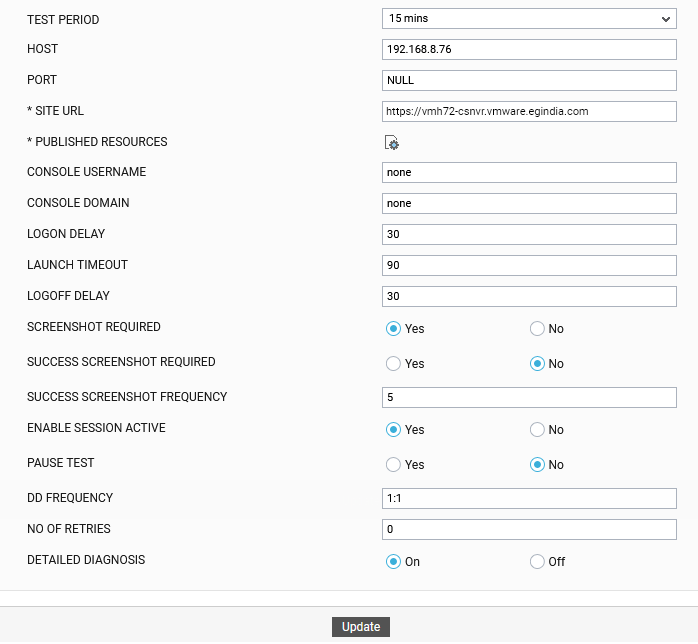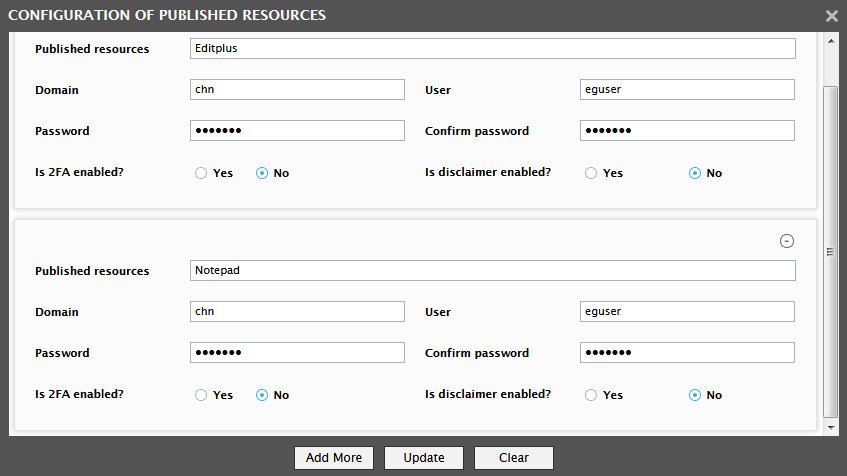How to Configure Published Resources for Monitoring?
To configure the applications / desktops that the simulator has to launch, click on the ![]() icon against Published Resources in .
icon against Published Resources in .

Figure 1 : The Omnissa Horizon Logon Simulator Test configuration page
Figure 2 will then appear.

Figure 2 : Configuring the published resources to be launched
Using Figure 2, you can easily configure multiple resources that you want the simulator to launch and also the valid user credentials for accessing each resource. For this, follow the steps below:
-
Provide a comma-separated list of Published resources to be launched. The resource can be an application / desktop. When providing application/desktop names, make sure you provide the same name using which the applications/desktops are displayed in the Access Point or Omnissa Horizon Connection Server web console. Also, make sure that the User you specify is authorized to launch all the applications/desktops configured in the comma-separated list of Published resources.
Typically, any application/desktop that is launched opens in a separate window. Sometimes, a different name may be displayed for the launched application/desktop in that window's title bar. If there is a mismatch between the resource name in the Access Point or the Omnissa Horizon Connection Server console and the resource name in the launched window title, then the simulator may wrongly report a successful launch as a failure. To avoid this, in such circumstances, your Published resources specification should be of the following format: <Application / Desktop Name as seen in the Access Point / Omnissa Horizon Connection Server console>:<Application/Desktop Name as displayed in the Window title>. For example, your specification can be: winword-Documn:winword.exe,excel-Dev:excel.exe
Note:
- The resources can be specified either in lower case or upper case or a combination of both.
-
The display name of the resources should not contain the following special characters:
`*+=#.|;\"\'<>\/[]{}()?
- Then, using the Domain, User, Password, and Confirm Password parameters, configure the credentials of the user who is authorized to launch the configured resources.
- Two-factor authentication (2FA), often referred to as two-step verification, is a security process in which the user provides two authentication factors to verify they are who they say they are. If Omnissa Horizon Connection Server is enabled with two-factor authentication, then to authenticate the specified User login, the Omnissa Horizon Connection Server will require an additional layer of security other than the Password you have provided. This can be any piece of information that only the User knows or has immediately in hand - such as a verification code that the Omnissa Horizon Connection Server provides. This is why, if the Omnissa Horizon Connection Server is enabled with twofactor authentication, you will have to set the Is 2FA enabled? flag to Yes, and then specify the verification code in the text box that appears alongside. On the other hand, if the server is not enabled with two-factor authentication, set this flag to No.
- Some high-security Omnissa Horizon environments may have been configured to display a 'disclaimer', whenever a user attempts to login to a server/desktop in the environment. Such disclaimers typically include statements that delimit the scope of access, uphold confidentiality or protect copyright laws, and mitigate the risk of virus infections or data losses that may be caused by unauthorized access. If such a disclaimer is enabled for your environment, then set the Is disclaimer enabled? flag to Yes. In this case, the simulator will accept the disclaimer and proceed with the simulation. If no such disclaimer has been configured for your environment, set this flag to No.
- If you do not want to configure any more resources for launching, then click the Update button in Figure 2 to save the changes. To add another resource for launching, click the Add More button. This will add an empty record to Figure 2. Here, specify the names of more Published resources, and then use the Domain, User, Password, and Confirm Password parameters to provide the credentials of a user who is authorized to launch those resources.
- At any given point in time, you can exclude/delete a resource from the simulation by clicking the
 button corresponding to that resource in Figure 2.
button corresponding to that resource in Figure 2. - You can also clear all the configured resources and their launch details at one shot, by clicking the Clear button in Figure 2.



